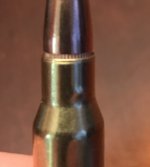Ike Clanton
New member
I loaded my first batch of 308. I found a round that had a small bulge around the neck. I believe some powder got stuck in the neck during the seating process since I can often see kernels stick to the inside of the neck. I showed two of my reloading buddies who say it’s safe to fire. Just want a second opinion. Thanks! PS let me know if the crimp looks good too.



